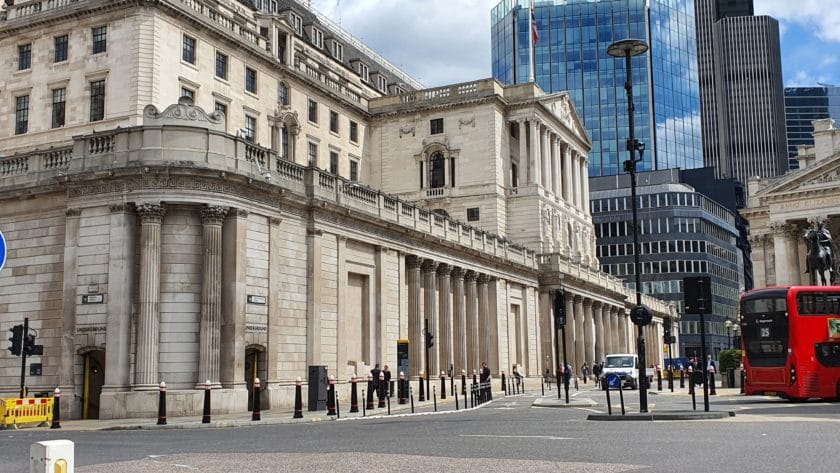Interest rates have hit their lowest level in over two years after the Bank of England voted to cut rates from 4.25% to 4% on Thursday.
While the drop in rates was widely expected, an unprecedented deadlocked initial vote saw the Monetary Policy Committee forced to vote a second time.
At its second vote, the MPC voted by a majority of 5-4 to reduce the bank rate with governor Andrew Bailey saying the Bank remains focussed on “squeezing out” any existing or emerging persistent inflationary pressures.
CPI inflation is currently 3.6%, above the bank’s 2% target, and is expected to peak at 4% in September, before falling back thereafter.
The Bank’s decision also comes amid a weakening jobs market and four-year high in unemployment.
George Lagarias, chief economist at Forvis Mazars, says: “While the rate cut was fully priced in by financial markets, the number of hawks on the MPC is somewhat of a surprise. Inflation may have picked up, but employment and growth conditions are deteriorating fast enough for many economists to assume that prices will eventually be pushed down as well.
“What will today’s move mean for consumers going forward? That there’s enough resistance in the Bank of England towards sharper cuts, for rates, and thus mortgages, to remain elevated for some time.”
Kevin Brown, savings expert at Scottish Friendly, comments: “The cut suggests policymakers believe that a slowing labour market and lacklustre economic growth will combine to bring inflation under control over the next few months.”
Impact on mortgages
The cut will ease some of the cost pressures facing those nearing the end of their fixed-rate mortgage deals, many of whom secured ultra-low rates during the historic lows of recent years.
Charlotte Kennedy, chartered financial planner at Rathbones, says: “This shift could also unlock a wave of would-be buyers who have been waiting in the wings, hoping for affordability to improve so they can take that first step onto the property ladder.”
Savings
Savers may find the Bank’s decision less welcome. Cash savings rates have been among the few beneficiaries of the Bank’s earlier rate hikes, but they will now be placed under pressure.
Thomas Lambert, financial planner at Quilter, says: “Banks and building societies are typically quick to respond to rate cuts, particularly on easy-access accounts, meaning the top rates may start to slip.
“Fixed-rate savings products may hold up for a little longer as institutions manage existing funding strategies, but the overall trend is clear. Those looking to make the most of their savings may want to consider locking in rates now, while they remain relatively high.”
David Hunt, head of savings at Investec Bank, says: “Today’s cut introduces uncertainty for savers and we anticipate a higher number to move their money into fixed rate products as they look to lock in attractive returns.
“This is the fifth base rate cut since last summer and we predict there are still more cuts to come later this year and into 2026. Savers need to act quickly if they want to move their money to fixed rate accounts with higher rates as we’re likely to see these start to disappear from the market.”
Pensions
For retirees considering their income options, the rate cut could mark a turning point.
Annuity rates, which have been particularly attractive in recent months as a result of high gilt yields, may start to decline.
Lambert says: “Anyone weighing up whether to convert part of their pension pot into a guaranteed income should take advice and consider acting sooner rather than later. While rates may not drop off a cliff, the window to secure particularly favourable terms could begin to narrow if this cycle of easing continues.”
For those in drawdown, the relative appeal of annuities versus staying invested may also shift.
“With lower interest rates potentially providing a tailwind to equity markets, there may be renewed value in keeping options open but only with a clear plan that balances income needs and risk tolerance,” adds Lambert.
Future cuts
Looking ahead, Richard Carter, head of fixed interest research at Quilter Cheviot, said: “The market hopes the Monetary Policy Committee will pull the trigger again this year, but as the division on the last few decisions shows, even that might be put in doubt with any small change to the data.”
Oliver Jones, head of allocation at Rathbones, added: “We expect the Bank of England to keep cutting interest rates once a quarter into next year. Despite the recent concerns about the quality of the data, it’s increasingly clear that the UK labour market is weakening with jobs vacancies generally below pre-pandemic levels and numbers of employees clearly falling.
“For these reasons we expect the Bank to keep loosening rates, despite inflation well above 3%. The biggest risk to this would be any evidence that inflation will not fall back as fast as expected next year.”
However, Lale Akoner, global market analyst at eToro, believes a “slower, steadier” approach would better serve the UK economy.
“Investors may welcome today’s move, but a November cut is far from guaranteed. From here, the path will likely be uneven. Credibility matters and getting this wrong could cost more in the long run,” says Akoner.































